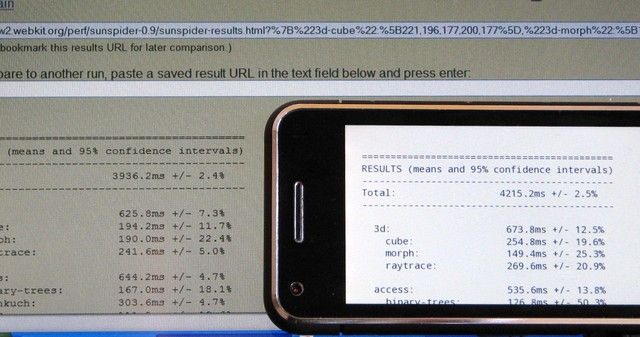
Posted on 08 July 2010
Note: Article title is a tounge-in-cheek reference to a recent ARSTechnica article. See below for the real story. It’s actually all about the browser engine and platform, not the OS.
As I begin a series of tests on the Aava prototype phone today, the first thing I wanted to get out of the way was a Sunspider javascript test. It’s CPU-intensive and forms an important part of the chain of events that take place to get a web application displayed on your browser. Yes, it’s one of many variables but it’s a good indicator of CPU performance.
I’ve been recording SunSpider tests for a long time now (feel free to contribute to that list) and have been very impressed by the way that both hardware and software improvements have brought the figures down. In the ARM-based world, the best-in-class devices are producing SunSpider results in less than 10 seconds (iPad, iPhone 4) with some new devices even reaching down to sub 6 seconds [See title reference.] In the world of Intel, netbooks are producing Sunspider results of about 2 seconds (using the latest Chrome build.)

Click to enlarge.
Above is the result for the Aava phone I’m testing at the moment. 4215ms. It runs on Intel’s Moorestown platform at 1.5Ghz and uses the same CPU as you find in netbooks. Running Sunspider on the latest Firefox build on the netbook and the Firefox Mobile build on the MeeGo-based Aava phone you can see the difference is marginal. 4.2 seconds for a prototype phone is quite impressive. The figures confirm the CPU speed and also confirm that the sunspider score is likely to drop to around 2 seconds with the latest Chrome or Android browser build. Try Sunspider on your phone or PC browser to see what score you get. For reference, I use a ultra mobile PC as my desktop PC. It runs a 1.6Ghz Atom CPU and returns a score of about 4.1s. True desktop PCs will come in at below 0.5s
We really are talking PC-power here but there are two things we must not forget. 1) Multi-core ARM-based devices are round the corner too. A dual-core 1.2Ghz Snapdragon platform is likely to reach right down to the 2-3s range. 2) We must also remember that if you were to run this test continuously on these high-power platforms, you are likely to have a dead phone in just a few hours!
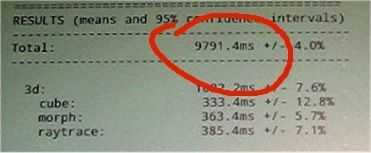
Posted on 05 June 2010
At an ARM event in Taipei this week I was fortunate enough to have a few minutes with a Tegra 2-based tablet prototype known as ‘Harmony.’ It’s a fairly standard tablet with a capacitive touchscreen and weighing in at the 700gm iPad-weight. You’ll see more details in the video below.
The interesting thing was the SunSpider javascript benchmark I did. As you might know, SunSpider is a well-recognized test of a browser’s ability to run javascript and it serves as a good data point for working out how fast a processor is. As far as I know, most, if not all, the javascript processing is done by the CPU.
You’ll see a result of 9.8 seconds on the video which is about the same as you’d see on the iPad. The iPad uses what we believe is an ARM A8 core, or at least something very similar. However, that doesn’t mean that dual-core Tegra 2 is only as powerful as a single-core A4 CPU because the two browsers are vastly different. The javascript engine on the iPad is super-fast where the engine used on the Android 2.1 browser isn’t.
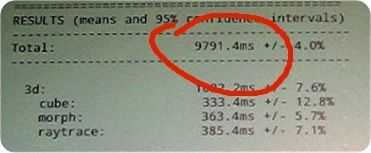
- Android 2.1 on Tegra 2 9 seconds (Tegra prototype shown in video)
- Android 2.2 on Snapdragon 1Ghz 6 seconds. (Nexus One, Google V8 engine)
- Android 1.6 on Snapdragon 1Ghz 24 seconds (Xperia X10)
- Android 1.6 on Snapdragon 1Ghz – 54 seconds (Dell Streak prototype)
- Chrome on Atom 1.6 2 seconds (average netbook, Google V8 engine)
As you can see there, the Android browser is at least 4 times less efficient in processing javascript on version 1.6 than it is on 2.2. I suspect that version 2.1 is close to 1.6 in its efficiency too which means that the Tegra 2 is over 200% faster than Snapdragon. Given that it has two cores, it’s not surprising. A single A9 core (in my estimate) brings about 20% more raw CPU performance over A8 so the figures look correct.
Add in the 4X improvement that you’ll see with Froyo’s Google V8 processing engine and there you go! Tegra2 with Froyo will be able to process javascript as well as a 1.6Ghz netbook. Just imagine what the 1.2Ghz dual-core Snapdragon will do!
More information about high-end ARM platforms in our primer, here.
We’ve already seen that ARM can beat Atom in certain low-end Atom scenarios and cross referencing to some other figures I have seem to confirm that ARM is going to challenge Atom in raw CPU. If only they could sort the operating system out and get some productivity apps going, we’d have some interesting smartbooks out there.
Chippy Sidenote: 2 cores needs 2x power! It would be interesting to work out the CPU drain figures under these javascript test conditions. Also note that system performance is not directly related to CPU performance. A lot of work has to go into a lot of other hardware and a lot of other software to get a system running ‘fast.’ Please remember that when Intel and ARM enter the clock-speed game over the next few years!

Posted on 31 May 2010
A summary of the ARM Press conference at Computex today. Speaker: Tudor Brown, President of ARM
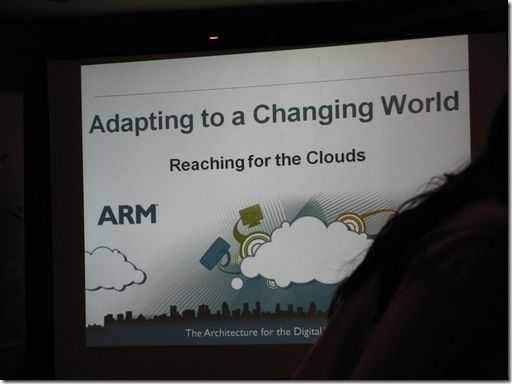
We’ve become used to ‘always on, anywhere.’
ARM go on to highlight the number of devices in it’s ecosystem.
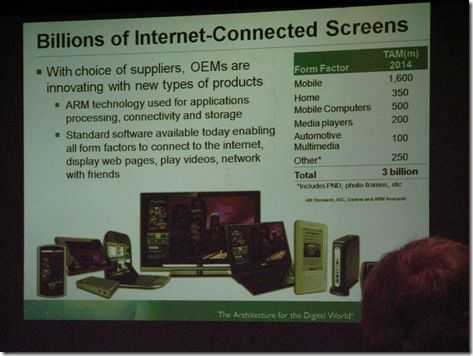
‘Eagle’ appears on Roadmap above Cortex A9.
Update: I asked what it was and ARM confirmed it’s the next-gen core for high-end platforms.
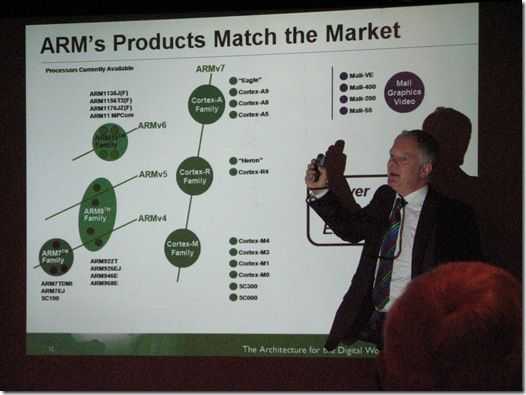
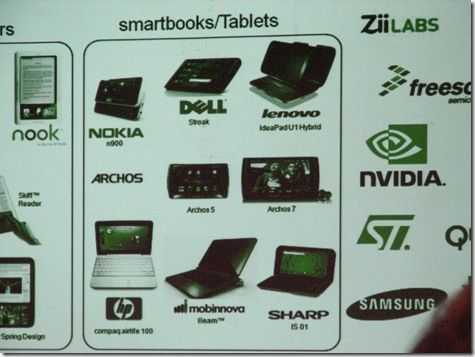
ARM goes on to highlight where ARM fits in in the home entertainment ecosystem and talks about the Digital Connected TV.
Mali appears
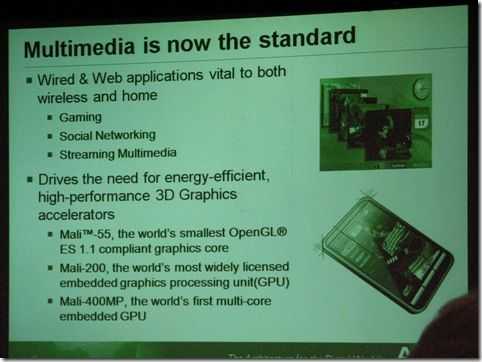
Highlights Android and Froyo and the ARM-specific optimizations.
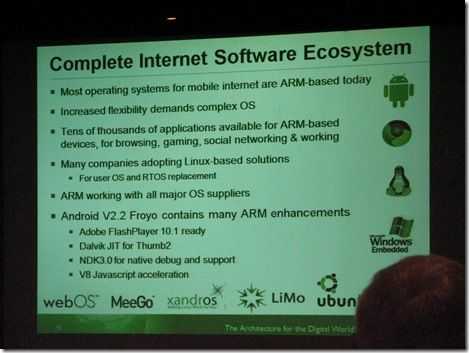
Q&A
I asked about Android for the emerging tablet space and the lack of . The response from ARM is that Google a looking at the option of marketplace and Google apps ‘very seriously.’
That’s it for now. I’ll try and get an interview later.

Posted on 31 May 2010
A summary of the ARM Press conference at Computex today. Speaker: Tudor Brown, President of ARM

We’ve become used to ‘always on, anywhere.’
ARM go on to highlight the number of devices in it’s ecosystem.

‘Eagle’ appears on Roadmap above Cortex A9.
Update: I asked what it was and ARM confirmed it’s the next-gen core for high-end platforms.


ARM goes on to highlight where ARM fits in in the home entertainment ecosystem and talks about the Digital Connected TV.
Mali appears

Highlights Android and Froyo and the ARM-specific optimizations.

Q&A
I asked about Android for the emerging tablet space and the lack of . The response from ARM is that Google a looking at the option of marketplace and Google apps ‘very seriously.’
That’s it for now. I’ll try and get an interview later.
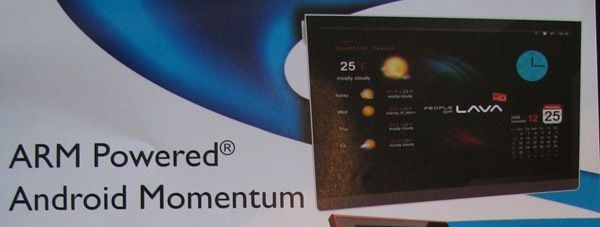
Posted on 31 May 2010
I just stopped by the ARM room at Computex to pre-register for the press event and they kindly gave me a press pack which gives a hint about what they’ll be talking about.
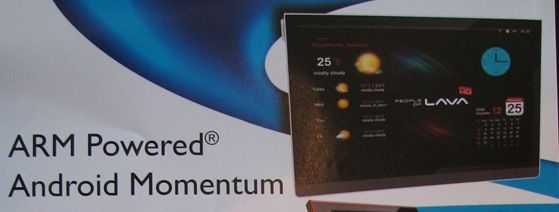
This is interesting because the press pack and press release talks almost exclusively about Android 2.2 as if nothing else mattered right now!
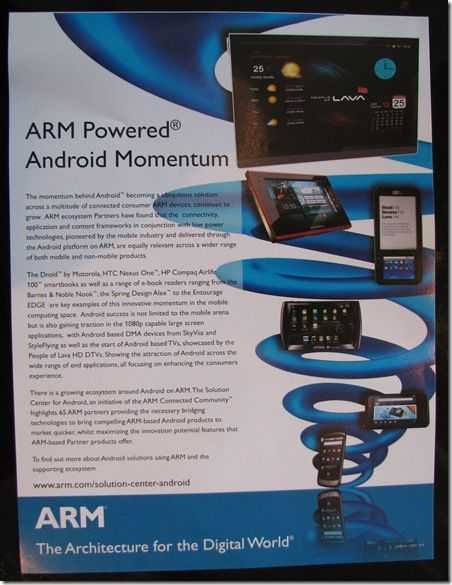

Posted on 31 May 2010
 Today is day Zero (many of you reading this will still living out Sunday but it’s already Monday here) and the action starts in just a few hours with a press conference from chip designer ARM. We’re not expecting anything new to be announced in our area because the Cortex A9 (multi-core ARMv7 architecture) is still just starting to ramp-up with OEMs but we might hear a little bit about Mali, the GPU architecture, and maybe some hints about future architectures. Mostly, we’re just expecting a partner parade and if we’re lucky, one or two product announcements and maybe, just maybe, some tips about how the operating system space is shaping up in ARM’s non-smartphone world.
Today is day Zero (many of you reading this will still living out Sunday but it’s already Monday here) and the action starts in just a few hours with a press conference from chip designer ARM. We’re not expecting anything new to be announced in our area because the Cortex A9 (multi-core ARMv7 architecture) is still just starting to ramp-up with OEMs but we might hear a little bit about Mali, the GPU architecture, and maybe some hints about future architectures. Mostly, we’re just expecting a partner parade and if we’re lucky, one or two product announcements and maybe, just maybe, some tips about how the operating system space is shaping up in ARM’s non-smartphone world.
Later today we’ll be hearing from ASUS and there’s an MSI press conference too that I’ll try and report on. Finally, I’ll be attending Mobile Monday here and maybe even giving a short talk on something. Handheld software is in my mind right now but we’ll see what comes up during the day.
Grab yourself a nice Jasmine Team, sit back and enjoy the show. You can go behind my scenes by checking out the stream at https://www.umpcportal.com/behind-the-scenes/ or for near real-time action, my twitter stream @chippy
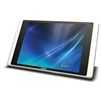
Posted on 27 May 2010
It there is one thing we know about JKK of JKKmobile, it’s his uncanny ability to cover huge amounts of distance at technology shows and exhibitions to produce first-look videos, by the bucket load so when he posts the following about Amtek prepping not 1 or 2 tablets but an incredible 5, we know we are in for a interesting Computex;
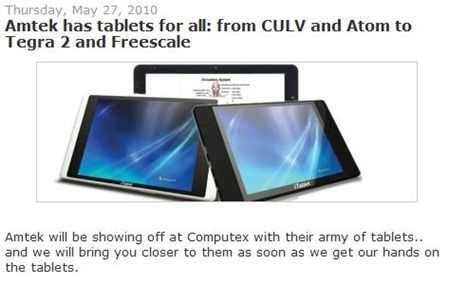
Firstly there is the iTablet Speed-Lite (AE03), packing a Nvidia Tegra 2 1Ghz, 1GB RAM, 2MP camera, 10.1 inch multi touch display and WiFi. Then there is the iTablet Ex-Lite II (AE04), wielding a Freescale 800MHz CPU, 512MB RAM, 2MP camera, 10.1 inch multi touch display and WiFi also. Both of these come with a choice of either WindowsCE 6.0R3/7.0, Android 2.0 or Linux and have options for bluetooth, 3G connectivity and GPS.
To add to these is the iTablet Lite (TZ10), sporting an Intel® Atom Menlow-XL Z530 1.6GHz CPU, 2GB of RAM, 10.1 inch multi touch display, 2MP camera, WiFi, 4200mAh battery, Windows 7 and a choice of either a 1.8 inch IDE HDD or a 64GB SSD.
Then the icing on the tablet cake in the form of T23A CULV tablet PC and the T23x CULV Series. All of which have Core 2 Duo 743 1.30GHz Intel Montevina Platform CPU’s, 2GB of RAM, 1.3MP cameras, 2.5 inch SATA HDD’s from 160GB to 320GB and coming with a choice of either a 12.1 inch XGA digitizer, touch or digitizer and touch screens.
If that doesn’t get your tablet juices going then head over to JKKmobile for the full specifications and pictures.





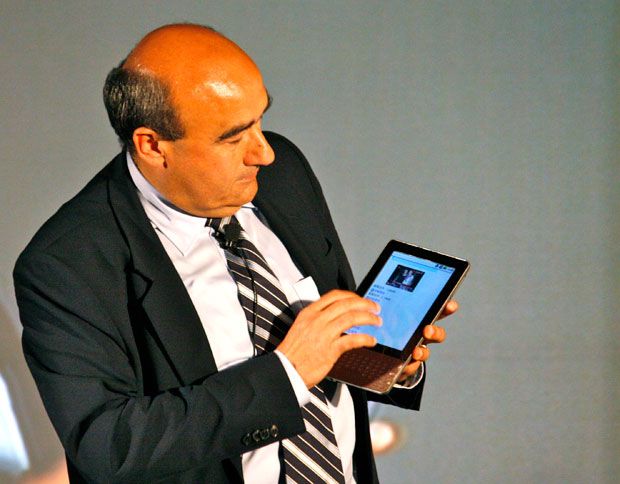
Posted on 27 May 2010
David Flynn of APCmag.com in Australia has uncovered an interesting device whilst at Acer’s Source Home conference in Beijing. The as-yet unnamed tablet devices is running Google’s Android operating system and sports a full QWERTY keyboard and embedded 3G.
APCmag qouted Acers CEO and president Gianfranco Lanci as saying the device should arrive in Q4 of these year. Lanci also states that although the tablet is similar to the iPad “We are not convinced that 10 inches is the right size for this type of device. It becomes too close to a netbook in size, and why should it not be a netbook with full PC capability? inch
The device will have Acer’s own user interface and be used primarily for “books, music and videos, browsing the internet, email and chatting inch Lanci says, he goes on to say that “Android is very good in terms of Internet browsing and connectivity. You can run it on an ARM processor at a certain speed and Android is light enough not to overload the CPU inch.

Further details are slim at the moment but from what I can tell it looks like it could make an excellent ebook reader. We’ll be keeping a look out for this at Computex next week.
via APCmag.com



































